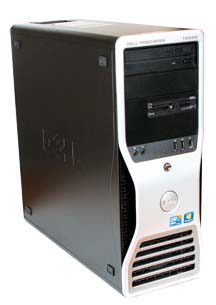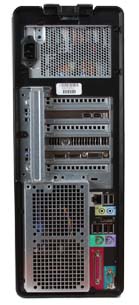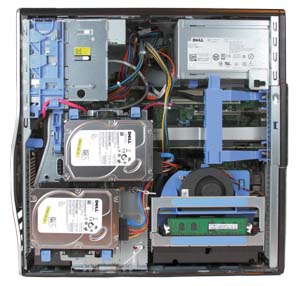Review: Dell Precision T5500 is a Power-Packed Tower
The dual-six-core Dell Precision T5500 workstation turns in impressive results--with a price to match.
December 4, 2001
By David Cohn
 The Dell Precision T5500 workstation packs incredible power and dual CPUs into a compact tower case. |
After having not reviewed a Dell workstation for quite some time, we were pleased to receive a second Precision workstation in less than a year. This time around, the Texas-based company sent us the latest version of its Precision T5500, a dual-socket system that packs a lot of power into a relatively compact tower.
The Dell Precision T5500 bears a striking resemblance to the T3500 we reviewed last year (see DE, March 2009), housed in a gray and black case measuring 6.73 x 17.64 x 18.54 in. (W x H x D) and weighing in at 41.5 lbs. And like the T3500, although configured as a tower, the T5500 can also be reoriented as a desktop system.
Quirky Interior
Like other workstations in the Dell Precision series, the T5500 case opens on the right. Inside, we again found an unusual hard drive mounting system. Up to two drives can be mounted on a special cage that hinges at the bottom of the case. When latched in place, the cage covers more than a quarter of the case. Drives simply snap into the cage and cables are properly routed for easy manual connection.
Swinging the drive cage out of the way exposes one of the CPUs. We could then remove the blue plastic memory shroud to expose a bank of six memory sockets, three of which were filled with 1GB dual in-line memory modules (DIMMs). Because we knew the system had two CPUs and a total of 6GB of memory, however, we wondered where Dell had hidden the additional memory and the second CPU.
 |
We soon solved the mystery. The second processor mounts on a separate dual processor riser. Located toward the rear of the hinged drive cage, this riser slides into a special slot and is held in place with a quick-release lever. The dual processor riser has its own heat sink and cooling fan, and also includes three more memory sockets. So, the second of the two 3.33GHz Intel Xeon X5680 six-core processors was mounted on this unique riser, along with three more 1GB memory modules.
The system supports up to 72GB of RAM if you install 8GB DIMMs into all nine memory sockets. While 1GB modules are certainly less expensive, they limit future expansion because only three memory sockets remain unpopulated. But the Dell website doesn’t offer a 6GB configuration option using larger memory modules.
Dell equipped our evaluation unit with a pair of 500GB Seagate Constellation ES SATA hard drives, configured in a redundant array of independent disks (RAID) 0 (striped) array, so that the drives appeared as a single 1TB drive. While this arrangement improves performance, it puts data more at risk—the failure of either drive would result in complete data loss.
Hidden beneath the hinged drive cage and the dual processor riser is a Dell motherboard based on an Intel 5520 chipset, with a total of six expansion slots: two PCIe x16 graphics slots, two PCIe x16 slots wired as x8, one PCIx slot and one PCI slot. There are also three more USB connections on the motherboard.
The PCI slot contained a FireWire card, while our evaluation unit also came with a single NVIDIA Quadro 5000 graphics accelerator installed in one of the PCIe x16 graphics slots. The Quadro 5000’s 152-watt power consumption means that an auxiliary power connector from the 875-watt power supply is required. In addition, it is a dual-slot board, blocking access to the adjacent PCIe slot.
All told, Dell offers 15 graphics card choices, including entry-level and mid-range workstation cards from NVIDIA and ATI, and the even more powerful NVIDIA Quadro 6000.
In spite of two large fans behind the front panel—one on the dual processor riser assembly, one in the power supply—and yet another on the graphics board, the Precision T5500 was virtually silent after startup.
 |
Great Performance , Premium Price
The Dell Precision T5500 marks the first workstation we’ve tested with dual six-core CPUs, so we had high expectations when we began our benchmark testing. We certainly weren’t disappointed. On the SPECviewperf test, which looks solely at graphics performance, the speedy CPU and ultra high-end graphics accelerator combined to produce some of the highest scores we’ve ever recorded. The only system to surpass the Dell’s performance was the over-clocked 3DBOXX 4860 Extreme (see DE, January 2011, page 14), which was equipped with an identical Quadro 5000 graphics card.
When we turned our attention to the SolidWorks benchmark, which is more of a real-world test and additionally breaks out graphics, CPU and I/O performance from the overall scores, the T5500 turned in excellent, but not record-setting results.
But when we ran our AutoCAD rendering test, which clearly shows the benefits of multiple cores, the results were nothing short of spectacular. With hyper-threading enabled, giving the equivalent of 24 processor cores, the Dell Precision T5500 completed our presentation quality rendering in just 28 seconds.
| Dell Precision T5500 • Price: $9,242 as tested ($1,299 base price) • Size: 6.73 x 17.64 x 18.54 in. (W x D x H) tower • Weight: 41.5 lbs. • CPU: two 3.33GHz Intel Xeon 6-core with 12MB L3 cache • Memory: 6GB 1,333MHz DDR3 SDRAM (72GB max) • Graphics: NVIDIA Quadro 5000 with 2.5GB memory • Hard disk: two 500GB Seagate ConstellationES SATA 7,200 rpm drive • Optical: one 16X DVD +/-RW • Audio: onboard integrated high-definition audio (microphone, headphone, line-in and line-out) • Network: integrated Broadcom 5761 Gigabit Ethernet LAN • Modem: none • Keyboard: 104-key Dell QuietKey USB • Pointing device: three-button USB optical mouse • Other: One 9-pin serial, one 25-pin parallel, eight USB 2.0 plus three internal USB, 19-in-1 media card reader |
The Dell Precision T5500 is backed by a basic 3-year warranty, with next-business-day, on-site service. Pro support with 24x7x365 service is available. So are 4- and 5-year service terms, accidental damage protection, data recovery protection and even a prepaid recycling service.
Prices for the Dell Precision T5500 start at $1,719, and with current promotions, that price drops to an even more attractive $1,299. But that figure won’t even begin to purchase the system we received. As configured, our evaluation unit priced out at $9,712. Even after instant online savings, the system would still cost $9,242. It’s a lofty sum, but it buys you an incredibly powerful Dell Precision T5500, capable of handling the most demanding engineering applications.
More Info:
Dell
Advanced Micro Devices
Broadcom
Intel Corp.
NVIDIA
Seagate
David Cohn is the technical publishing manager at 4D Technologies. He also does consulting and technical writing from his home in Bellingham, WA, and has been benchmarking PCs since 1984. He’s a contributing editor to Desktop Engineering and the author of more than a dozen books. You can contact him via email at [email protected] or visit his website at DSCohn.com.
Subscribe to our FREE magazine, FREE email newsletters or both!
About the Author
David Cohn is a consultant and technical writer based in Bellingham, WA, and has been benchmarking PCs since 1984. He is a Contributing Editor to Digital Engineering, the former senior content manager at 4D Technologies, and the author of more than a dozen books. Email at [email protected] or visit his website at www.dscohn.com.
Follow DE





